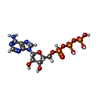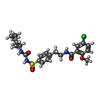+ Open data
Open data
- Basic information
Basic information
| Entry | Database: PDB / ID: 9kgl | ||||||||||||||||||
|---|---|---|---|---|---|---|---|---|---|---|---|---|---|---|---|---|---|---|---|
| Title | Structure of KATP channel in complex with centipede toxin SpTx1 | ||||||||||||||||||
 Components Components |
| ||||||||||||||||||
 Keywords Keywords | TRANSPORT PROTEIN / KATP / Kir6.2 / SUR1 / Glibenclamide / SpTx1 | ||||||||||||||||||
| Function / homology |  Function and homology information Function and homology informationDefective ABCC9 causes CMD10, ATFB12 and Cantu syndrome / ATP sensitive Potassium channels / Defective ABCC8 can cause hypo- and hyper-glycemias / ATP-activated inward rectifier potassium channel activity / glutamate secretion, neurotransmission / response to resveratrol / inward rectifying potassium channel / sulfonylurea receptor activity / ventricular cardiac muscle tissue development / CAMKK-AMPK signaling cascade ...Defective ABCC9 causes CMD10, ATFB12 and Cantu syndrome / ATP sensitive Potassium channels / Defective ABCC8 can cause hypo- and hyper-glycemias / ATP-activated inward rectifier potassium channel activity / glutamate secretion, neurotransmission / response to resveratrol / inward rectifying potassium channel / sulfonylurea receptor activity / ventricular cardiac muscle tissue development / CAMKK-AMPK signaling cascade / voltage-gated monoatomic ion channel activity involved in regulation of presynaptic membrane potential / regulation of monoatomic ion transmembrane transport / ATPase-coupled monoatomic cation transmembrane transporter activity / nervous system process / : / ankyrin binding / neuromuscular process / response to ATP / potassium ion import across plasma membrane / potassium ion binding / action potential / voltage-gated potassium channel activity / potassium channel activity / positive regulation of insulin secretion involved in cellular response to glucose stimulus / ABC-type transporter activity / cellular response to nutrient levels / Ion homeostasis / potassium ion transmembrane transport / T-tubule / regulation of insulin secretion / response to ischemia / determination of adult lifespan / regulation of membrane potential / Regulation of insulin secretion / negative regulation of insulin secretion / ADP binding / sarcolemma / ABC-family proteins mediated transport / glucose metabolic process / presynapse / transmembrane transporter binding / response to hypoxia / response to xenobiotic stimulus / apoptotic process / ATP hydrolysis activity / ATP binding / metal ion binding / plasma membrane / cytoplasm Similarity search - Function | ||||||||||||||||||
| Biological species |  Homo sapiens (human) Homo sapiens (human) Mesocricetus auratus (golden hamster) Mesocricetus auratus (golden hamster) Scolopendra polymorpha (arthropod) Scolopendra polymorpha (arthropod) | ||||||||||||||||||
| Method | ELECTRON MICROSCOPY / single particle reconstruction / cryo EM / Resolution: 2.88 Å | ||||||||||||||||||
 Authors Authors | Chen, L. | ||||||||||||||||||
| Funding support |  China, 1items China, 1items
| ||||||||||||||||||
 Citation Citation |  Journal: To Be Published Journal: To Be PublishedTitle: Structure of KATP in complex with SpTx1 Authors: Chen, L. / Wang, M. | ||||||||||||||||||
| History |
|
- Structure visualization
Structure visualization
| Structure viewer | Molecule:  Molmil Molmil Jmol/JSmol Jmol/JSmol |
|---|
- Downloads & links
Downloads & links
- Download
Download
| PDBx/mmCIF format |  9kgl.cif.gz 9kgl.cif.gz | 1.2 MB | Display |  PDBx/mmCIF format PDBx/mmCIF format |
|---|---|---|---|---|
| PDB format |  pdb9kgl.ent.gz pdb9kgl.ent.gz | 996.5 KB | Display |  PDB format PDB format |
| PDBx/mmJSON format |  9kgl.json.gz 9kgl.json.gz | Tree view |  PDBx/mmJSON format PDBx/mmJSON format | |
| Others |  Other downloads Other downloads |
-Validation report
| Summary document |  9kgl_validation.pdf.gz 9kgl_validation.pdf.gz | 1.7 MB | Display |  wwPDB validaton report wwPDB validaton report |
|---|---|---|---|---|
| Full document |  9kgl_full_validation.pdf.gz 9kgl_full_validation.pdf.gz | 1.7 MB | Display | |
| Data in XML |  9kgl_validation.xml.gz 9kgl_validation.xml.gz | 163.3 KB | Display | |
| Data in CIF |  9kgl_validation.cif.gz 9kgl_validation.cif.gz | 257.6 KB | Display | |
| Arichive directory |  https://data.pdbj.org/pub/pdb/validation_reports/kg/9kgl https://data.pdbj.org/pub/pdb/validation_reports/kg/9kgl ftp://data.pdbj.org/pub/pdb/validation_reports/kg/9kgl ftp://data.pdbj.org/pub/pdb/validation_reports/kg/9kgl | HTTPS FTP |
-Related structure data
| Related structure data |  62322MC  62754 C: citing same article ( M: map data used to model this data |
|---|---|
| Similar structure data | Similarity search - Function & homology  F&H Search F&H Search |
- Links
Links
- Assembly
Assembly
| Deposited unit | 
|
|---|---|
| 1 |
|
- Components
Components
| #1: Protein | Mass: 43595.723 Da / Num. of mol.: 4 Source method: isolated from a genetically manipulated source Source: (gene. exp.)  Homo sapiens (human) / Gene: KCNJ11 / Production host: Homo sapiens (human) / Gene: KCNJ11 / Production host:  Homo sapiens (human) / References: UniProt: Q14654 Homo sapiens (human) / References: UniProt: Q14654#2: Protein | Mass: 177295.594 Da / Num. of mol.: 4 Source method: isolated from a genetically manipulated source Source: (gene. exp.)  Mesocricetus auratus (golden hamster) / Gene: Abcc8 / Production host: Mesocricetus auratus (golden hamster) / Gene: Abcc8 / Production host:  Homo sapiens (human) / References: UniProt: A0A1U7R319 Homo sapiens (human) / References: UniProt: A0A1U7R319#3: Protein | | Mass: 6527.552 Da / Num. of mol.: 1 Source method: isolated from a genetically manipulated source Source: (gene. exp.)  Scolopendra polymorpha (arthropod) / Production host: Scolopendra polymorpha (arthropod) / Production host:  #4: Chemical | ChemComp-ATP / #5: Chemical | ChemComp-GBM / Has ligand of interest | N | Has protein modification | Y | |
|---|
-Experimental details
-Experiment
| Experiment | Method: ELECTRON MICROSCOPY |
|---|---|
| EM experiment | Aggregation state: PARTICLE / 3D reconstruction method: single particle reconstruction |
- Sample preparation
Sample preparation
| Component | Name: KATP in complex with SpTx1 / Type: COMPLEX / Entity ID: #1-#3 / Source: RECOMBINANT |
|---|---|
| Source (natural) | Organism:  Homo sapiens (human) Homo sapiens (human) |
| Source (recombinant) | Organism:  Homo sapiens (human) Homo sapiens (human) |
| Buffer solution | pH: 7.5 |
| Specimen | Embedding applied: NO / Shadowing applied: NO / Staining applied: NO / Vitrification applied: YES |
| Vitrification | Cryogen name: ETHANE |
- Electron microscopy imaging
Electron microscopy imaging
| Experimental equipment |  Model: Titan Krios / Image courtesy: FEI Company |
|---|---|
| Microscopy | Model: TFS KRIOS |
| Electron gun | Electron source:  FIELD EMISSION GUN / Accelerating voltage: 300 kV / Illumination mode: FLOOD BEAM FIELD EMISSION GUN / Accelerating voltage: 300 kV / Illumination mode: FLOOD BEAM |
| Electron lens | Mode: BRIGHT FIELD / Nominal defocus max: 2500 nm / Nominal defocus min: 1000 nm |
| Image recording | Electron dose: 50 e/Å2 / Film or detector model: GATAN K2 SUMMIT (4k x 4k) |
- Processing
Processing
| CTF correction | Type: NONE |
|---|---|
| 3D reconstruction | Resolution: 2.88 Å / Resolution method: FSC 0.143 CUT-OFF / Num. of particles: 246583 / Symmetry type: POINT |
 Movie
Movie Controller
Controller





 PDBj
PDBj














